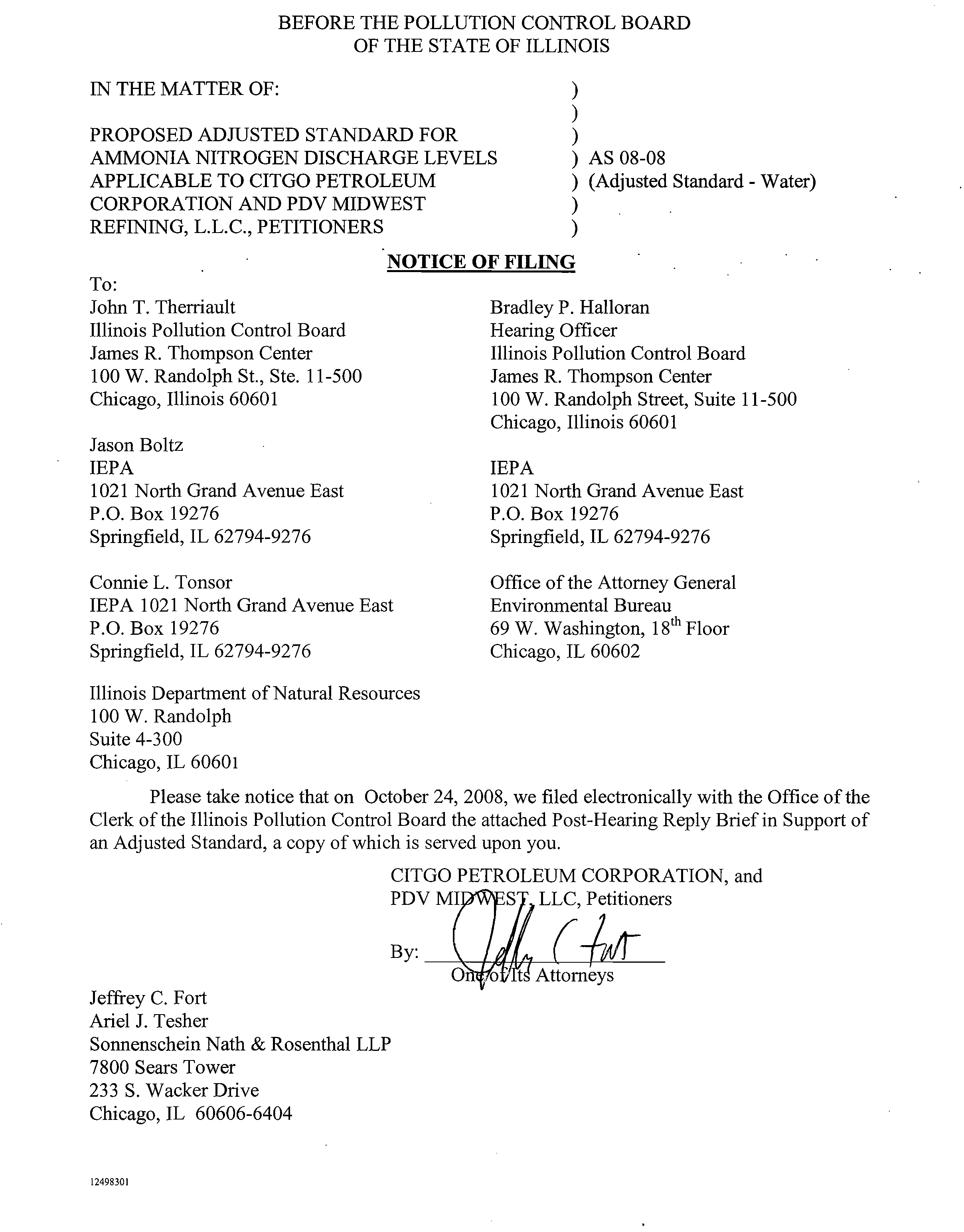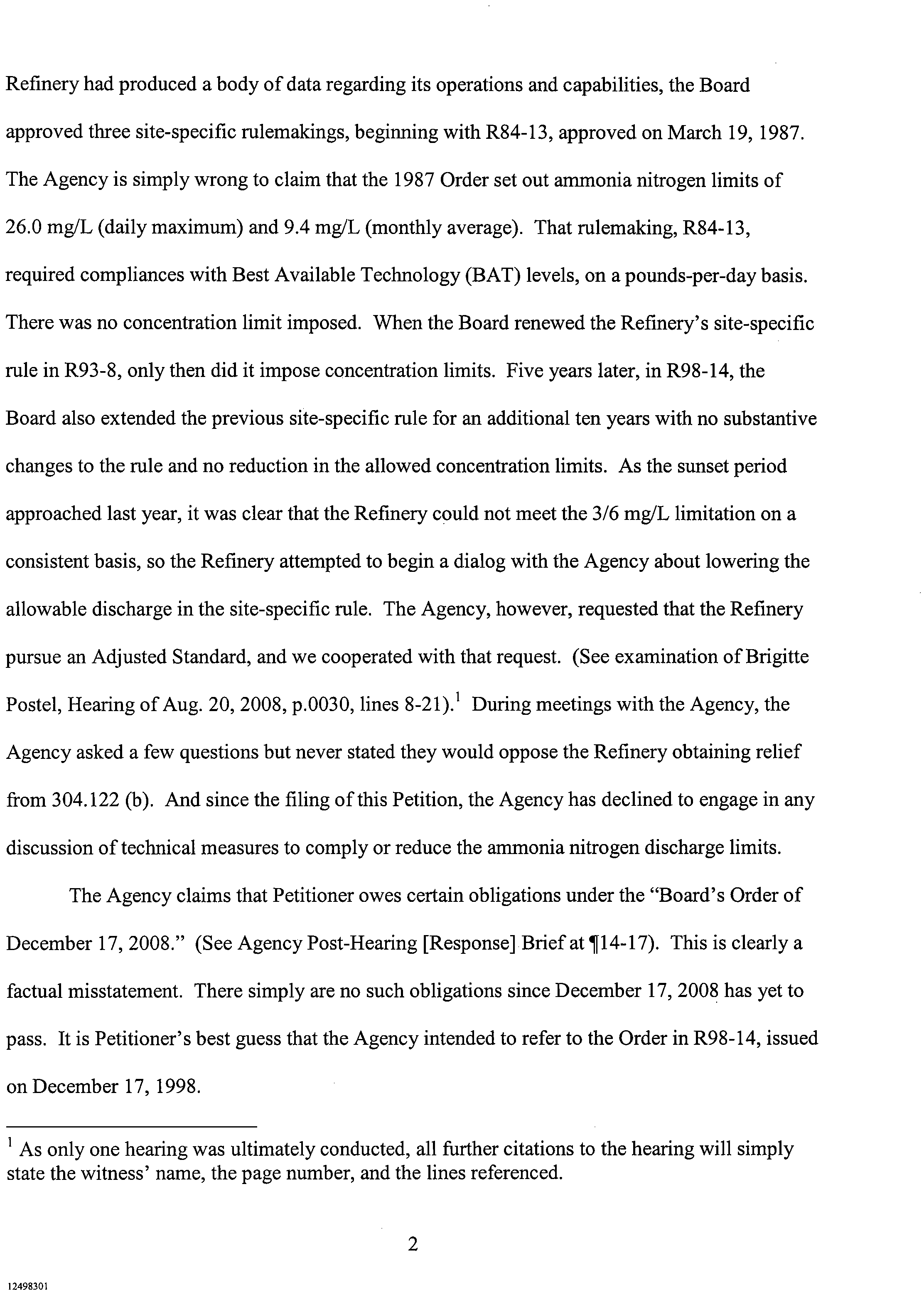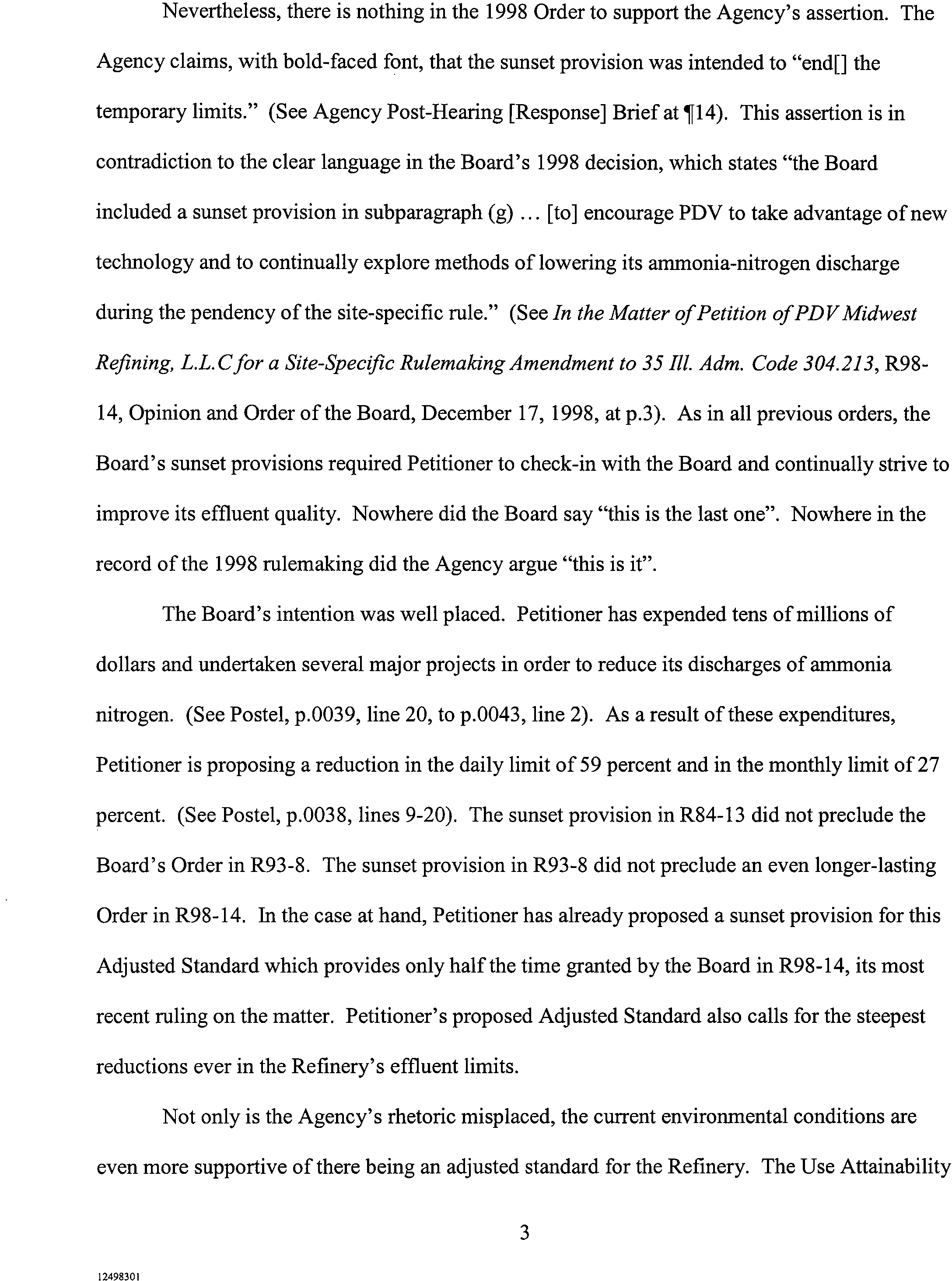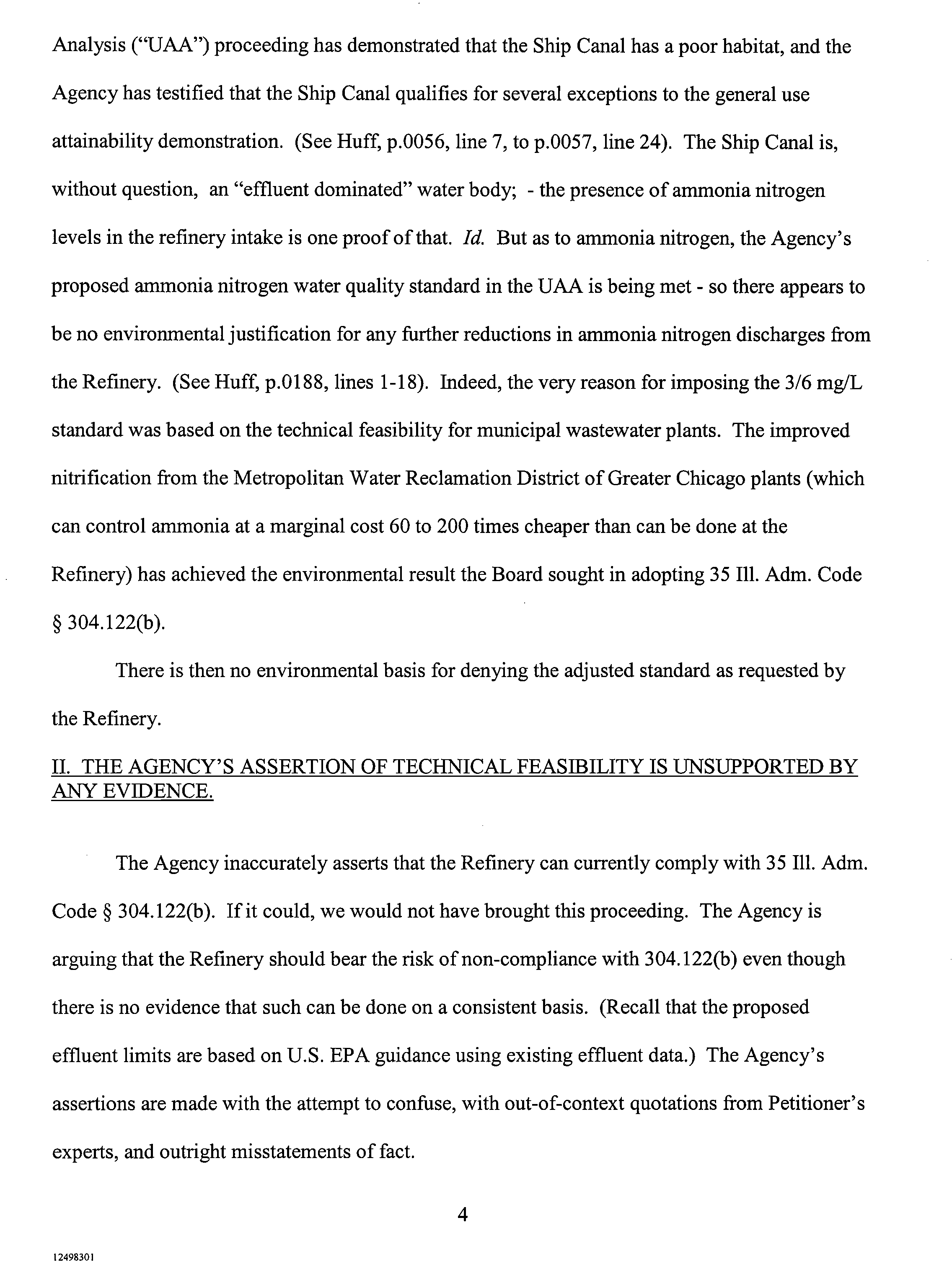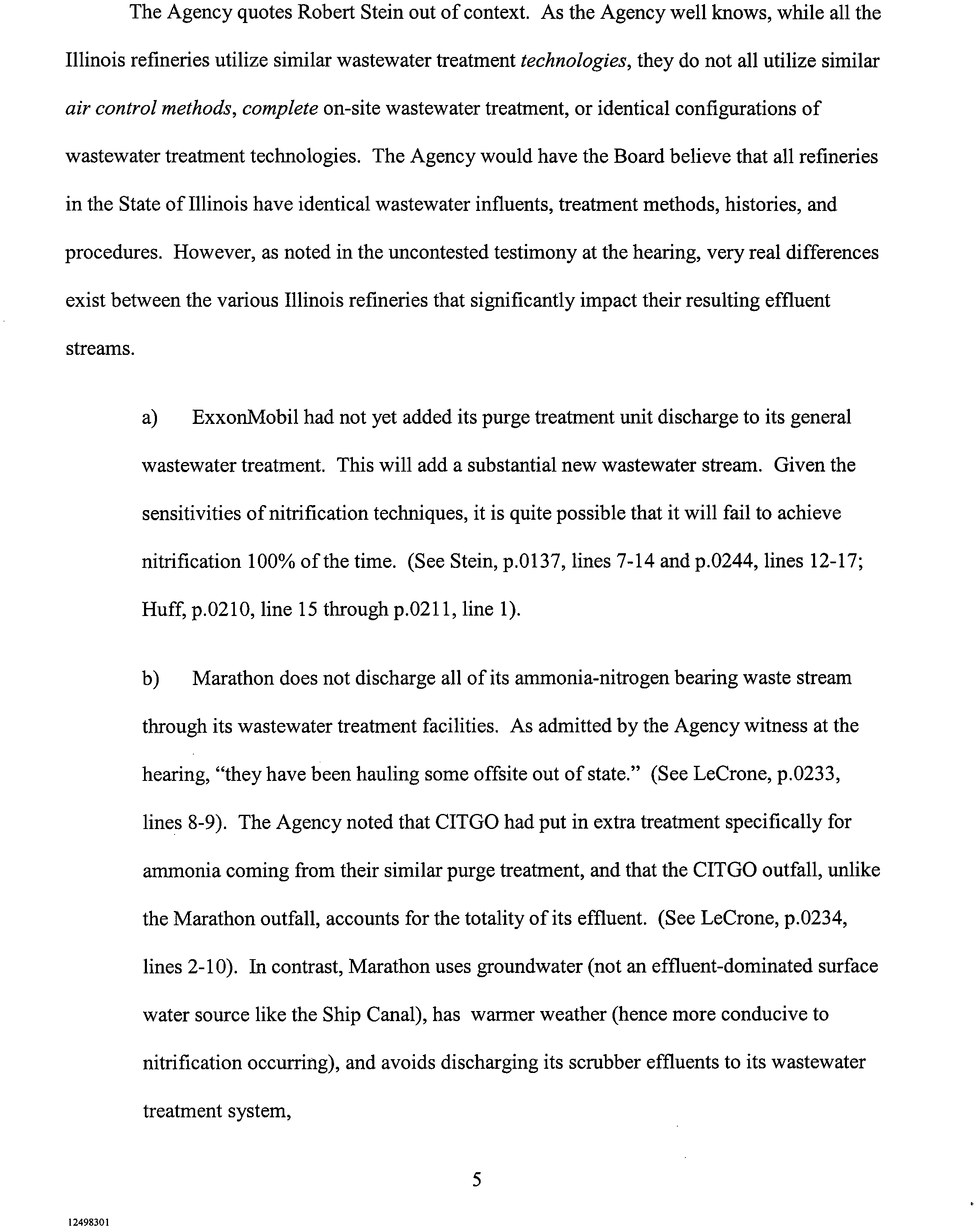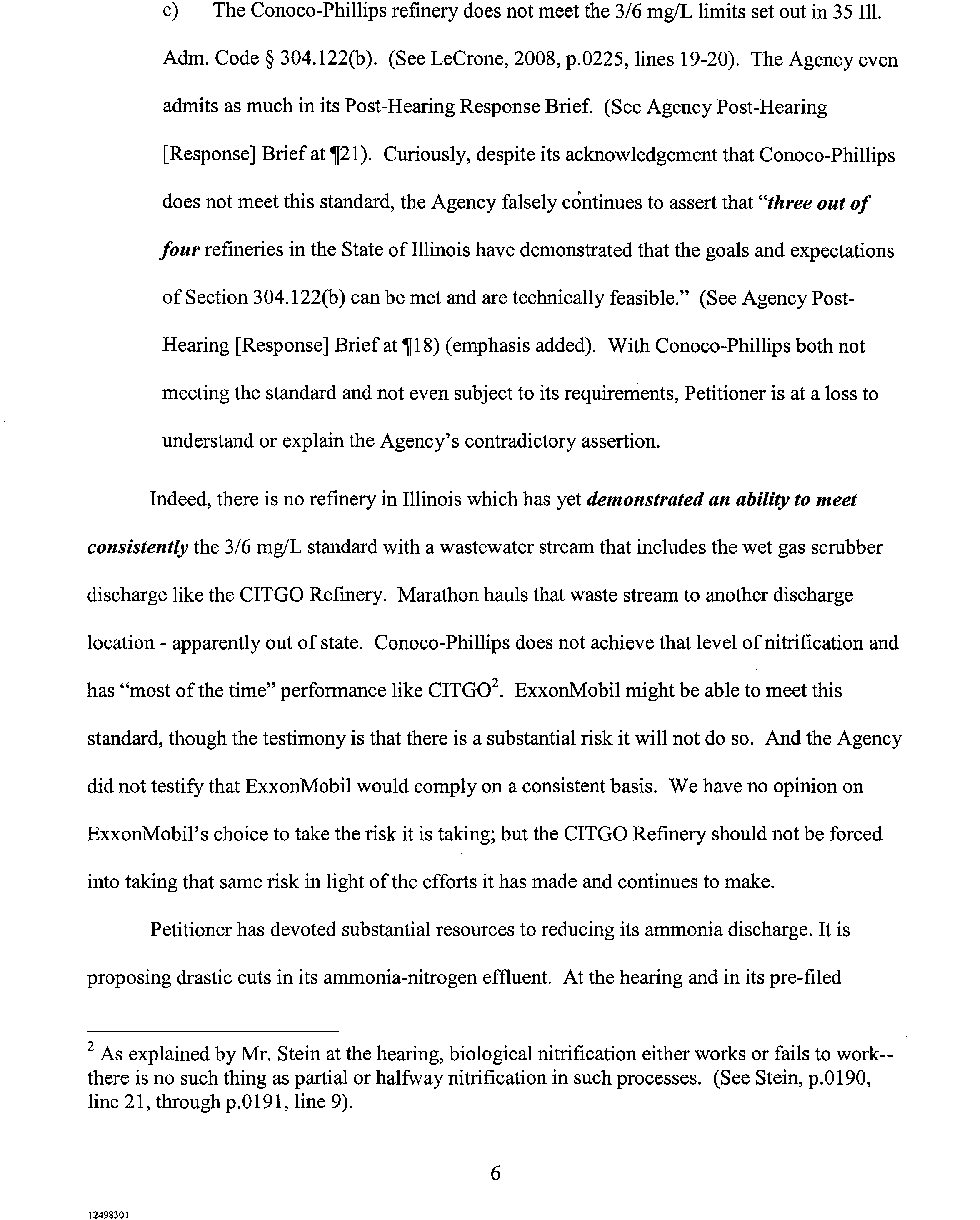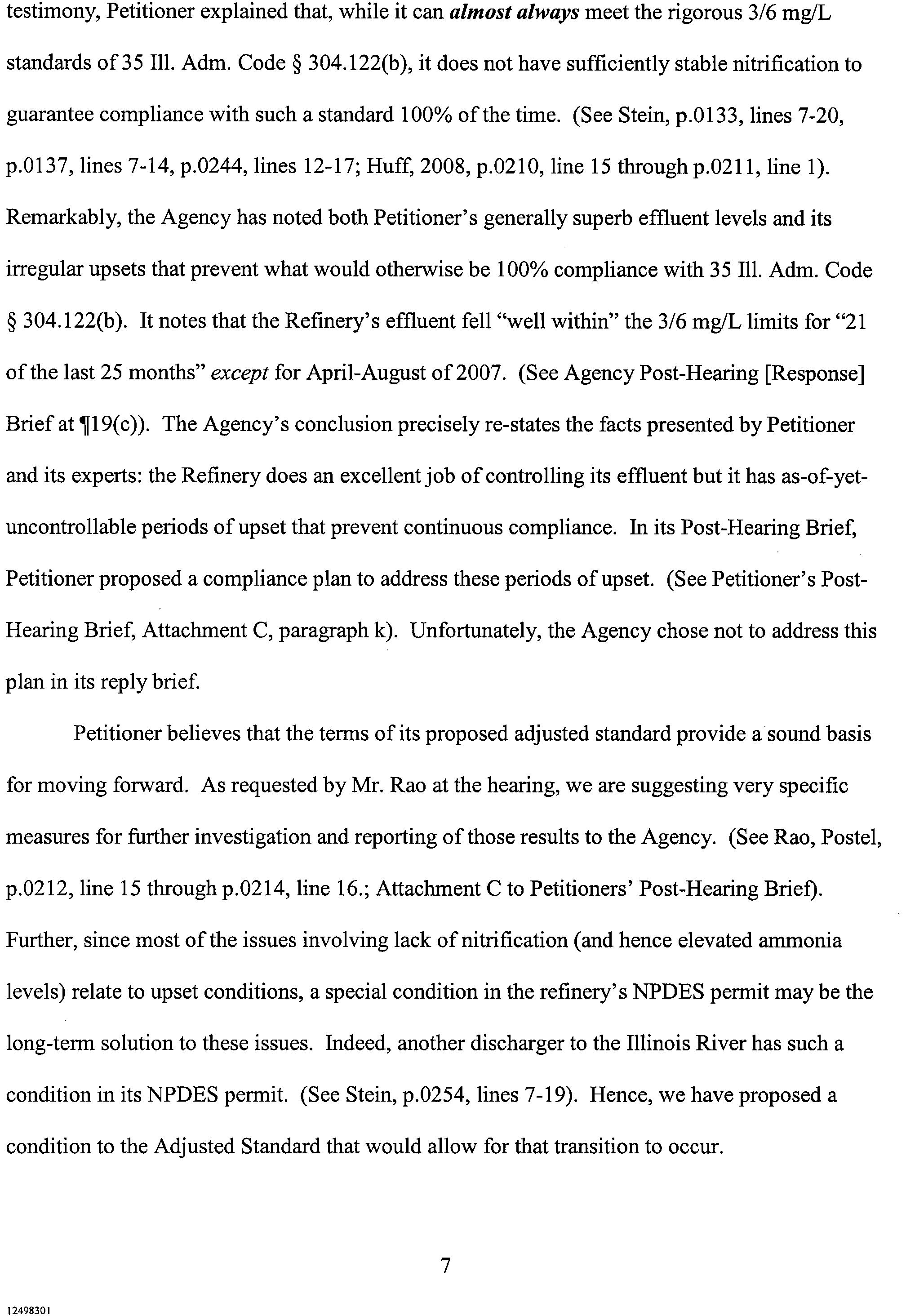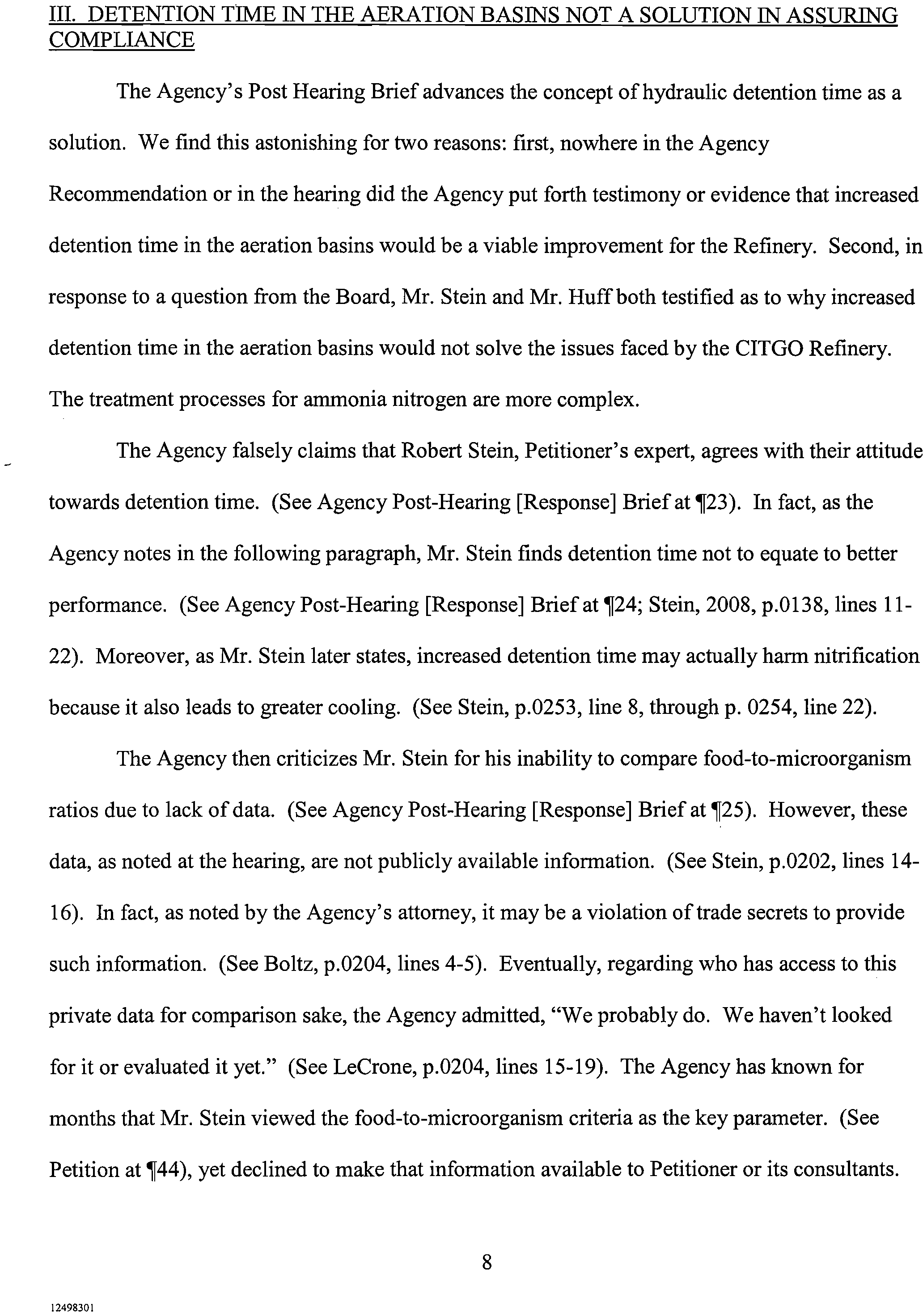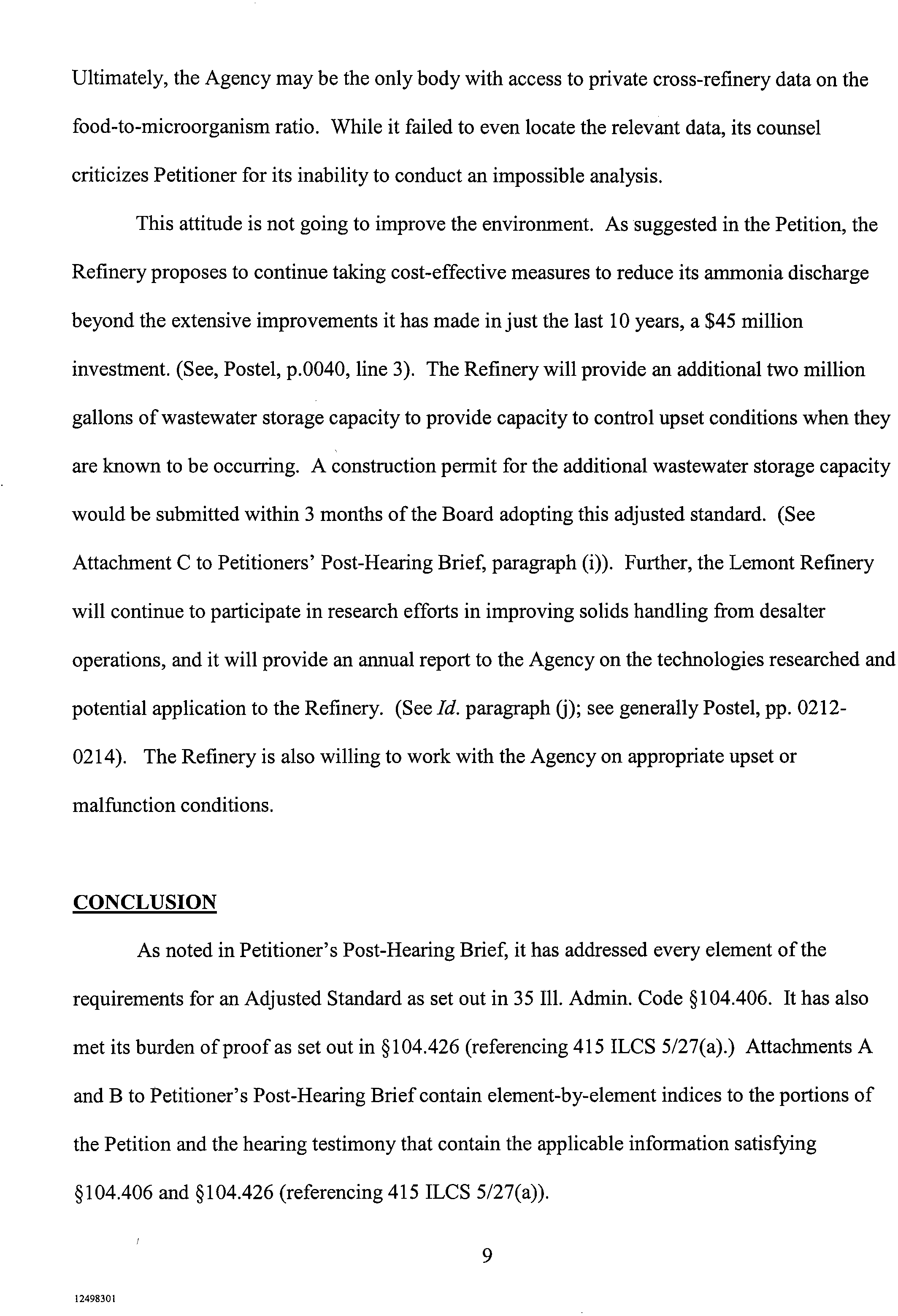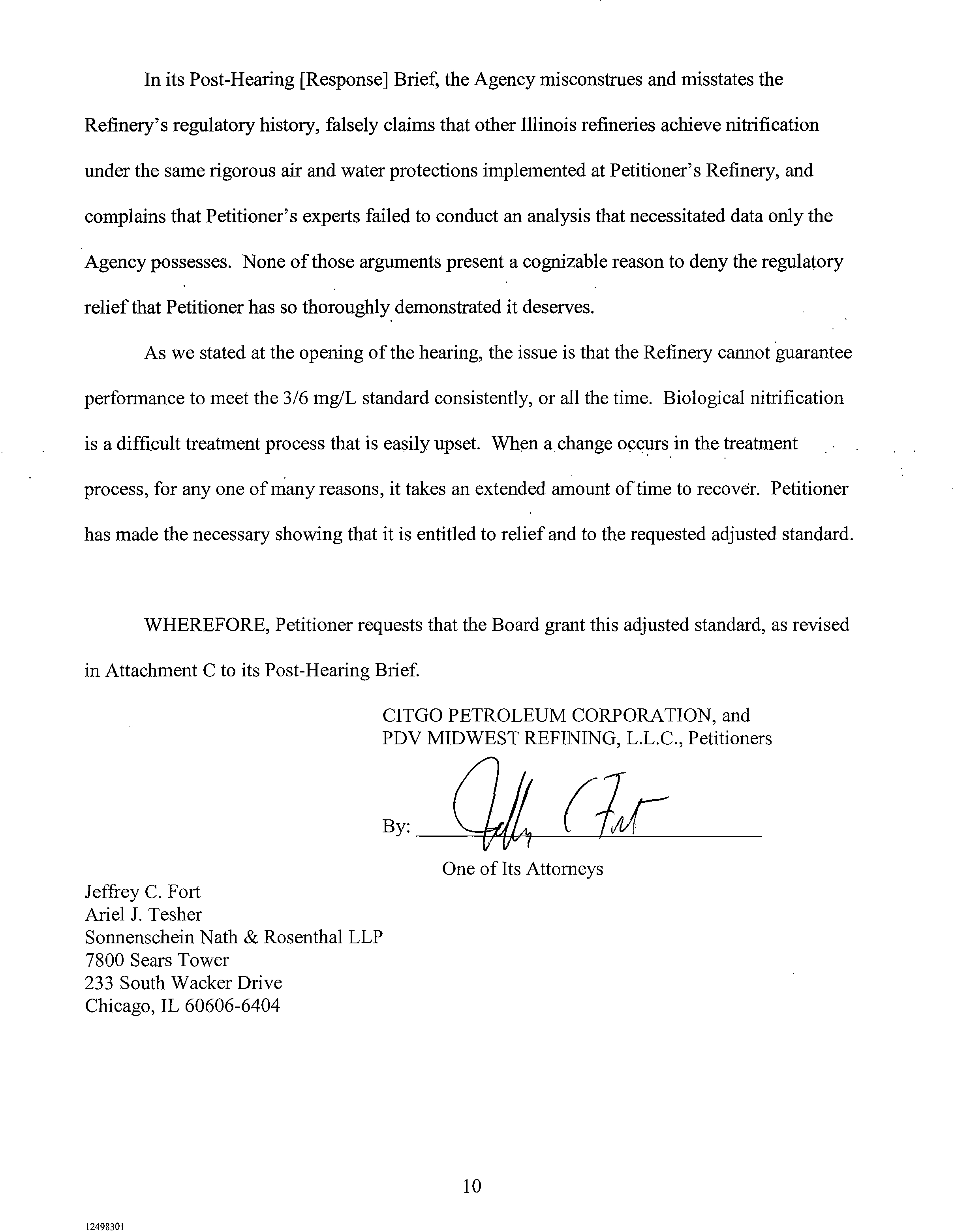BEFORE THE POLLUTION CONTROL BOARD
OF THE STATE OF ILLINOIS
IN
THE MATTER OF:
)
)
PROPOSED ADJUSTED STANDARD FOR
)
AMMONIA NITROGEN DISCHARGE LEVELS
) AS 08-08
APPLICABLE
TO CITGO PETROLEUM
) (Adjusted Standard - Water)
CORPORATION AND PDV MIDWEST
)
REFINING, L.L.C., PETITIONERS
)
NOTICE OF FILING
To:
John T. Therriault
Illinois Pollution Control Board
James
R. Thompson Center
100 W. Randolph St., Ste. 11-500
Chicago, Illinois 60601
Jason Boltz
IEPA
1021 North Grand Avenue East
P.O.
Box 19276
Springfield, IL 62794-9276
Connie
L.
Tonsor
IEPA 1
021 North Grand Avenue East
P.O. Box 19276
Springfield, IL 62794-9276
Bradley P. Halloran
Hearing Officer
Illinois Pollution Control Board
James R. Thompson Center
100 W. Randolph Street, Suite 11-500
Chicago, Illinois 60601
IEPA
1
021 North Grand Avenue East
P.O. Box 19276
Springfield, IL 62794-9276
Office
of the Attorney General
Environmental Bureau
69 W. Washington,
18
th
Floor
Chicago, IL 60602
Illinois Department
of Natural Resources
100 W. Randolph
Suite 4-300
Chicago, IL 60601
Please take notice that
on October 24, 2008, we filed electronically with the Office of the
Clerk of the Illinois Pollution Control Board the attached Post-Hearing Reply Brief in Support of
an Adjusted Standard, a copy of which is served upon you.
CITGO PETROLEUM CORPORATION, and
PDV MI
S LLC, Petitioners
Jeffrey
C. Fort
Ariel
J. Tesher
Sonnenschein Nath
&
Rosenthal LLP
7800 Sears Tower
233 S. Wacker Drive
Chicago, IL 60606-6404
12498301
Electronic Filing - Received, Clerk's Office, October 24, 2008
BEFORE THE POLLUTION CONTROL BOARD
OF THE STATE OF ILLINOIS
IN THE MATTER OF:
PROPOSED ADJUSTED STANDARD FOR
AMMONIA NITROGEN DISCHARGE LEVELS
APPLICABLE TO CITGO PETROLEUM
CORPORATION AND PDV MIDWEST
REFINING, L.L.C., PETITIONERS
)
)
)
) AS 08-08
) (Adjusted Standard - Water)
)
)
POST-HEARING REPLY BRIEF IN SUPPORT OF AN ADJUSTED STANDARD
The Post-Hearing Brief of the Agency provides no factual or other information to
contradict the testimony and evidence submitted by Petitioners. In this Reply Brief, CITGO
Petroleum Corporation and PDV Midwest Refining, (hereinafter, "Petitioner" or "the Refinery")
will point out the misstatements of fact and errors in analysis contained in the Agency brief.
Further, the Agency did not respond in any constructive manner to the proposed conditions of the
adjusted standard.
ARGUMENT: THE AGENCY'S BASIS FOR RECOMMENDING DENIAL IS
SPECIOUS, AND BASED
ON A MIS-READING OF THE REGULATORY HISTORY
AND THE RECORD.
I. THE AGENCY'S ACCOUNT OF LEMONT REFINERY'S PAST REGULATORY
HISTORY
IS INCORRECT.
The Agency'sresponse
brief opens with a purported history of the Refinery'sprevious
regulatory matters. While the Board did grant variances in the early years of Illinois' ammonia-
nitrogen rule, such variances were for 1-2 year periods.
(Compare
Agency Post-Hearing
[Response] Brief at
~3).
These variances were intended for the Refinery to gather sufficient data
about its operations in advance of a site-specific regulatory change. (See
Union Oil Company of
California v. IEPA,
R82-87, Opinion and Order of the Board, October 5, 1982 at p.3). Once the
1
12498301
Electronic Filing - Received, Clerk's Office, October 24, 2008
Refinery had produced a body of data regarding its operations and capabilities, the Board
approved three site-specific rulemakings, beginning with R84-13, approved on March 19, 1987.
The Agency is simply wrong to claim that the 1987 Order set out ammonia nitrogen limits
of
26.0 mg/L (daily maximum) and 9.4 mg/L (monthly average). That rulemaking, R84-13,
required compliances with Best Available Technology (BAT) levels, on a pounds-per-day basis.
There was no concentration limit imposed. When the Board renewed the Refinery's site-specific
rule in R93-8, only then did it impose concentration limits. Five years later, in R98-14, the
Board also extended the previous site-specific rule for an additional ten years with no substantive
changes to the rule and no reduction in the allowed concentration limits. As the sunset period
approached last year, it was clear that the Refinery could not meet the 3/6 mg/L limitation on a
consistent basis, so the Refinery attempted to begin a dialog with the Agency about lowering the
allowable discharge
in the site-specific rule. The Agency, however, requested that the Refinery
pursue an Adjusted Standard, and we cooperated with that request. (See examination of Brigitte
Postel, Hearing
of Aug. 20,2008, p.0030, lines 8-21).1 During meetings with the Agency, the
Agency asked a few questions but never stated they would oppose the Refinery obtaining relief
from 304.122 (b). And since the filing of this Petition, the Agency has declined to engage in any
discussion of technical measures to comply or reduce the ammonia nitrogen discharge limits.
The Agency claims that Petitioner owes certain obligations under the "Board'sOrder of
December 17, 2008." (See Agency Post-Hearing [Response]Brief at
~14-17).
This is clearly a
factual misstatement. There simply are no such obligations since December 17, 2008 has yet to
pass.
It
is Petitioner'sbest guess that the Agency intended to refer to the Order in R98-14, issued
on December 17, 1998.
1As only one hearing was ultimately conducted, all further citations to the hearing will simply
state the witness' name, the page number, and the lines referenced.
2
12498301
Electronic Filing - Received, Clerk's Office, October 24, 2008
Nevertheless, there is nothing in the 1998 Order to support the Agency's assertion. The
Agency claims, with bold-faced font, that the sunset provision was intended to "end[] the
temporary limits." (See Agency Post-Hearing [Response]
Brief at ,-r14). This assertion is in
contradiction to the clear language in the Board's 1998 decision, which states "the Board
included a sunset provision in subparagraph (g)
... [to] encourage PDV to take advantage of new
technology and to continually explore methods
of lowering its ammonia-nitrogen discharge
during the pendency
of the site-specific rule." (See
In the Matter ofPetition ofPDV Midwest
Refining, L.L.Cfor a Site-Specific Rulemaking Amendment to
35
Ill. Adm. Code 304.213,
R98-
14, Opinion and Order of the Board, December 17, 1998, at p.3). As in all previous orders, the
Board's sunset provisions required Petitioner to check-in with the Board and continually strive to
improve its effluent quality. Nowhere did the Board say "this is the last one". Nowhere in the
record
of the 1998 rulemaking did the Agency argue "this is it".
The
Board'sintention was well placed. Petitioner has expended tens of millions of
dollars and undertaken several major projects in order to reduce its discharges of ammonia
nitrogen. (See Postel, p.0039, line 20, to p.0043, line 2). As a result
of these expenditures,
Petitioner is proposing a reduction in the daily limit of 59 percent and in the monthly limit of27
percent. (See Postel, p.0038, lines 9-20). The sunset provision in R84-13 did not preclude the
Board'sOrder in R93-8. The sunset provision in R93-8 did not preclude an even longer-lasting
Order in R98-14. In the case at hand, Petitioner has already proposed a sunset provision for this
Adjusted Standard which provides only
half the time granted by the Board in R98-14, its most
recent ruling
on the matter. Petitioner'sproposed Adjusted Standard also calls for the steepest
reductions ever in the Refinery's effluent limits.
Not only is the Agency's rhetoric misplaced, the current environmental conditions are
even more supportive
of there being an adjusted standard for the Refinery. The Use Attainability
3
12498301
Electronic Filing - Received, Clerk's Office, October 24, 2008
Analysis ("UAA") proceeding has demonstrated that the Ship Canal has a poor habitat, and the
Agency has testified that the Ship Canal qualifies for several exceptions to the general use
attainability demonstration. (See Huff, p.0056, line 7, to p.0057, line 24). The Ship Canal is,
without question, an "effluent dominated" water body; - the presence
of ammonia nitrogen
levels in the refinery intake is one
proof of that.
Id.
But as to ammonia nitrogen, the Agency's
proposed ammonia nitrogen water quality standard in the
UAA is being met - so there appears to
be no environmental justification for any further reductions in ammonia nitrogen discharges from
the Refinery. (See Huff, p.0188, lines 1-18). Indeed, the very reason for imposing the 3/6 mg/L
standard was based
on the technical feasibility for municipal wastewater plants. The improved
nitrification from the Metropolitan Water Reclamation District
of Greater Chicago plants (which
can control ammonia at a marginal cost 60 to 200 times cheaper than can be done at the
Refinery) has achieved the environmental result the Board sought
in adopting 35 Ill. Adm. Code
§ 304.122(b).
There is then no environmental basis for denying the adjusted standard as requested
by
the Refinery.
II.
THE AGENCY'S ASSERTION OF TECHNICAL FEASIBILITY IS UNSUPPORTED BY
ANY EVIDENCE.
The Agency inaccurately asserts that the Refinery can currently comply with 35 Ill. Adm.
Code
§ 304.122(b). Ifit could, we would not have brought this proceeding. The Agency is
arguing that the Refinery should bear the risk of non-compliance with 304. 122(b) even though
there is no evidence that such can be done
on a consistent basis. (Recall that the proposed
effluent limits are based
on U.S. EPA guidance using existing effluent data.) The Agency's
assertions are made with the attempt to confuse, with out-of-context quotations from Petitioner's
experts, and outright misstatements
of fact.
4
12498301
Electronic Filing - Received, Clerk's Office, October 24, 2008
The Agency quotes Robert Stein out of context. As the Agency well knows, while all the
Illinois refineries utilize similar wastewater treatment
technologies,
they do not all utilize similar
air control methods, complete
on-site wastewater treatment, or identical configurations of
wastewater treatment technologies. The Agency would have the Board believe that all refineries
in the State of Illinois have identical wastewater influents, treatment methods, histories, and
procedures. However, as noted in the uncontested testimony at the hearing, very real differences
exist between the various Illinois refineries that significantly impact their resulting effluent
streams.
a)
ExxonMobil had not yet added its purge treatment unit discharge to its general
wastewater treatment. This will add a substantial new wastewater stream. Given the
sensitivities
of nitrification techniques, it is quite possible that it will fail to achieve
nitrification 100%
of the time. (See Stein, p.0137, lines 7-14 and p.0244, lines 12-17;
Huff, p.0210, line 15 through p.0211, line 1).
b)
Marathon does not discharge all
of its ammonia-nitrogen bearing waste stream
through its wastewater treatment facilities. As admitted by the Agency witness at the
hearing, "they have been hauling some offsite out of state." (See LeCrone, p.0233,
lines 8-9). The Agency noted that CITGO had put in extra treatment specifically for
ammonia coming from their similar purge treatment, and that the CITGO outfall, unlike
the Marathon outfall, accounts for the totality of its effluent. (See LeCrone, p.0234,
lines 2-10). In contrast, Marathon uses groundwater (not an effluent-dominated surface
water source like the Ship Canal), has warmer weather (hence more conducive to
nitrification occurring), and avoids discharging its scrubber effluents to its wastewater
treatment system,
5
12498301
Electronic Filing - Received, Clerk's Office, October 24, 2008
c)
The Conoco-Phillips refinery does not meet the 3/6 mg/L limits set out in 35 Ill.
Adm. Code
§ 304.122(b). (See LeCrone, 2008, p.0225, lines 19-20). The Agency even
admits as much in its Post-Hearing Response Brief. (See Agency Post-Hearing
[Response]
Briefat
~21).
Curiously, despite its acknowledgement that Conoco-Phillips
does not meet this standard, the Agency falsely continues to assert that
"three out
of
four
refineries in the State of Illinois have demonstrated that the goals and expectations
of Section 304. I22(b) can be met and are technically feasible." (See Agency Post-
Hearing [Response] Brief at
~18)
(emphasis added). With Conoco-Phillips both not
meeting the standard and not even subject to its requirements, Petitioner is at a loss to
understand or explain the Agency's contradictory assertion.
Indeed, there is no refinery in Illinois which has yet
demonstrated
an ability to meet
consistently
the 3/6 mg/L standard with a wastewater stream that includes the wet gas scrubber
discharge like the CITGO Refinery. Marathon hauls that waste stream to another discharge
location - apparently out
of state. Conoco-Phillips does not achieve that level of nitrification and
has "most
of the time" performance like CITG0
2
.
ExxonMobil might be able to meet this
standard, though the testimony is that there is a substantial risk it will not do so. And the Agency
did not testify that ExxonMobil would comply on a consistent basis. We have no opinion on
ExxonMobil'schoice to take the risk it is taking; but the CITGO Refinery should not be forced
into taking that same risk in light
of the efforts it has made and continues to make.
Petitioner has devoted substantial resources to reducing its ammonia discharge.
It
is
proposing drastic cuts in its ammonia-nitrogen effluent. At the hearing and in its pre-filed
2 As explained by Mr. Stein at the hearing, biological nitrification either works or fails to work--
there
is no such thing as partial or halfway nitrification in such processes. (See Stein, p.0190,
line 21, through p.019l, line 9).
6
12498301
Electronic Filing - Received, Clerk's Office, October 24, 2008
testimony, Petitioner explained that, while it can
almost always
meet the rigorous 3/6 mg/L
standards
of 35 Ill. Adm. Code § 304. 122(b), it does not have sufficiently stable nitrification to
guarantee compliance with such a standard 100%
of the time. (See Stein, p.0133, lines 7-20,
p.0137, lines 7-14, p.0244, lines 12-17; Huff, 2008, p.0210, line 15 through p.0211, line 1).
Remarkably, the Agency has noted both Petitioner'sgenerally superb effluent levels and its
irregular upsets that prevent what would otherwise
be 100% compliance with 35 Ill. Adm. Code
§ 304.122(b).
It
notes that the Refinery's effluent fell "well within" the 3/6 mg/L limits for "21
of the last 25 months"
except
for April-August of2007. (See Agency Post-Hearing [Response]
Brief at
~19(
c)). The Agency's conclusion precisely re-states the facts presented by Petitioner
and its experts: the Refinery does an excellent job of controlling its effluent but it has as-of-yet-
uncontrollable periods of upset that prevent continuous compliance. In its Post-Hearing Brief,
Petitioner proposed a compliance plan to address these periods
of upset. (See Petitioner'sPost-
Hearing Brief, Attachment C, paragraph k). Unfortunately, the Agency chose not to address this
plan in its reply brief.
Petitioner believes that the terms
of its proposed adjusted standard provide a.sound basis
for moving forward. As requested
by Mr. Rao at the hearing, we are suggesting very specific
measures for further investigation and reporting
of those results to the Agency. (See Rao, Postel,
p.0212, line 15 through p.0214, line 16.; Attachment C to Petitioners' Post-Hearing Brief).
Further, since most
of the issues involving lack of nitrification (and hence elevated ammonia
levels) relate to upset conditions, a special condition in the refinery'sNPDES permit may be the
long-term solution to these issues. Indeed, another discharger to the Illinois River has such a
condition in its NPDES permit. (See Stein, p.0254, lines 7-19). Hence,
we have proposed a
condition to the Adjusted Standard that would allow for that transition to occur.
7
12498301
Electronic Filing - Received, Clerk's Office, October 24, 2008
III. DETENTION TIME IN THE AERATION BASINS NOT A SOLUTION IN ASSURING
COMPLIANCE
The Agency'sPost Hearing Brief advances the concept
of hydraulic detention time as a
solution. We find this astonishing for two reasons: first, nowhere in the Agency
Recommendation or in the hearing did the Agency put forth testimony or evidence that increased
detention time in the aeration basins would be a viable improvement for the Refinery. Second, in
response to a question from the Board, Mr. Stein and Mr.
Huffboth testified as to why increased
detention time in the aeration basins would not solve the issues faced
by the CITGO Refinery.
The treatment processes for ammonia nitrogen are more complex.
The Agency falsely claims that Robert Stein, Petitioner'sexpert, agrees with their attitude
towards detention time. (See Agency Post-Hearing [Response] Briefat
~23).
In
fact, as the
Agency notes in the following paragraph, Mr. Stein finds detention time not to equate to better
performance. (See Agency Post-Hearing [Response] Brief at
~24;
Stein, 2008, p.0138, lines 11-
22). Moreover, as Mr. Stein later states, increased detention time may actually harm nitrification
because it also leads to greater cooling. (See Stein, p.0253, line
8, through p. 0254, line 22).
The Agency then criticizes Mr. Stein for his inability
to compare food-to-microorganism
ratios due to lack
of data. (See Agency Post-Hearing [Response] Brief at
~25).
However, these
data, as noted at the hearing, are not publicly available information. (See Stein, p.0202, lines 14-
16).
In
fact, as noted by the Agency's attorney, it may be a violation oftrade secrets to provide
such information. (See Boltz, p.0204, lines 4-5). Eventually, regarding who has access to this
private data for comparison sake, the Agency admitted, "We probably do. We haven'tlooked
for it or evaluated it yet." (See LeCrone, p.0204, lines 15-19). The Agency has known for
months that Mr. Stein viewed the food-to-microorganism criteria
as the key parameter. (See
Petition at
~44),
yet declined to make that information available to Petitioner or its consultants.
8
12498301
Electronic Filing - Received, Clerk's Office, October 24, 2008
Ultimately, the Agency may be the only body with access to private cross-refinery data on the
food-to-microorganism ratio. While it failed to even locate the relevant data, its counsel
criticizes Petitioner for its inability to conduct an impossible analysis.
This attitude is not going to improve the environment. As suggested in the Petition, the
Refinery proposes to continue taking cost-effective measures to reduce its ammonia discharge
beyond the extensive improvements it has made
in just the last 10 years, a $45 million
investment. (See, Postel, p.0040, line 3). The Refinery will provide an additional two million
gallons of wastewater storage capacity to provide capacity to control upset conditions when they
are known to
be occurring. A construction permit for the additional wastewater storage capacity
would be submitted within 3 months
of the Board adopting this adjusted standard. (See
Attachment C to Petitioners' Post-Hearing Brief, paragraph (i)). Further, the Lemont Refinery
will continue to participate in research efforts in improving solids handling from desalter
operations, and it will provide an annual report to the Agency on the technologies researched and
potential application to the Refinery. (See
Id.
paragraph (j); see generally Postel, pp. 0212-
0214). The Refinery is also willing to work with the Agency on appropriate upset or
malfunction conditions.
CONCLUSION
As noted in Petitioner'sPost-Hearing Brief, it has addressed every element of the
requirements for an Adjusted Standard as set out in 35 Ill. Admin. Code §104.406.
It
has also
met its burden
of proof as set out in §104.426 (referencing 415 ILCS 5/27(a).) Attachments A
and B to Petitioner'sPost-Hearing Brief contain element-by-element indices to the portions of
the Petition and the hearing testimony that contain the applicable information satisfying
§104.406 and §104.426 (referencing 415 ILCS 5/27(a)).
9
12498301
Electronic Filing - Received, Clerk's Office, October 24, 2008
By:
In its Post-Hearing [Response] Brief, the Agency misconstrues and misstates the
Refinery's regulatory history, falsely claims that other Illinois refineries achieve nitrification
under the same rigorous air and water protections implemented at Petitioner's Refinery, and
complains that Petitioner's experts failed to conduct an analysis that necessitated data only the
Agency possesses. None
of those arguments present a cognizable reason to deny the regulatory
reliefthat Petitioner has so thoroughly demonstrated it deserves.
As we stated at the opening
of the hearing, the issue is that the Refinery cannot 'guarantee
performance to meet the 3/6 mg/L standard consistently, or all the time. Biological nitrification
is a diffi.cult treatment process that is easily upset.
Wh~n
achange
o~c~rsin
the treatment
process, for
anyone of many reasons, it takes an extended amount oftime to recover. Petitioner
has made the necessary showing that it is entitled to relief and to the requested adjusted standard.
WHEREFORE, Petitioner requests that the Board grant this adjusted standard, as revised
in Attachment C to its Post-Hearing Brief.
CITGO PETROLEUM CORPORATION, and
PDV MIDWEST REFINING,
L.L.c.,
Petitioners
GJh
(IF
One of Its Attorneys
Jeffrey
C. Fort
Ariel
1.
Tesher
Sonnenschein Nath
&
Rosenthal LLP
7800 Sears Tower
233 South Wacker Drive
Chicago, IL 60606-6404
10
12498301
Electronic Filing - Received, Clerk's Office, October 24, 2008
CERTIFICATE OF SERVICE
The undersigned, an attorney, certifies that he has served upon the individuals named on
the attached Notice
of Filing true and correct copies ofthe Post-Hearing Reply Brief in Support
of an Adjusted Standard by electronic service and First Class Mail, postage prepaid, on October
24,2008.
12498301
Electronic Filing - Received, Clerk's Office, October 24, 2008
